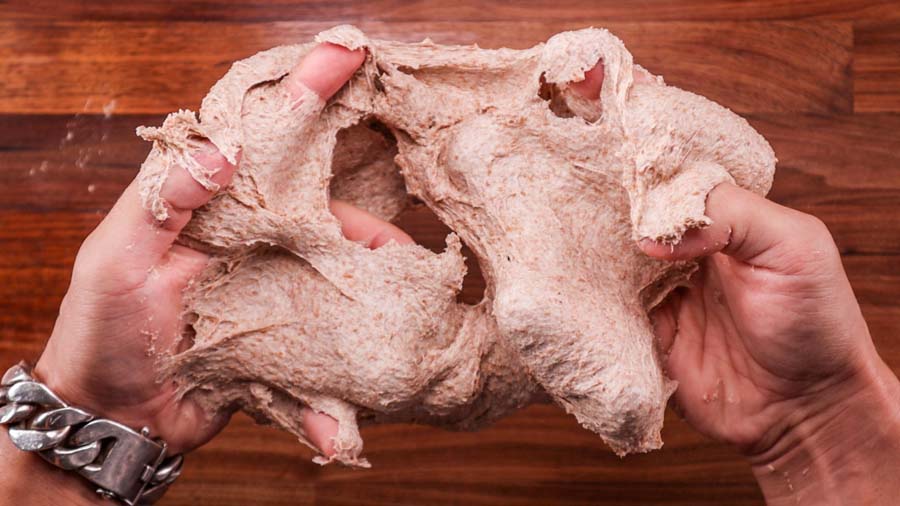I always warned people who asked me about converting hand mixed recipes to be made with a mixer. I told them that a mixer is more aggressive, and they should be careful not to overmix the dough. But how easy is it really to overmix bread dough?
Following my mixer conversion video, I thought I would put my warnings to the test and see if I’m talking nonsense or not. Because as far as I can remember I only overmixed a dough once. It was a high hydration focaccia dough that I was beating up on high speed. Duh.
What happens to a dough when it is overmixed?
With each revolution of the mixing arm the dough is picked up and twisted. This whipping movement incorporates oxygen into the dough. Over oxidized dough is said to lose its creamy colour and become white and lose its wheat-y aroma.
Sufficient oxidization is important for gluten development. If mixed too long the dough can become loose and sticky. The water that was absorbed by the flour gets released back into the dough and the gluten structure breaks down. After this there is no way to fix it. It will be a loose, soggy, and sticky mass unable to hold in fermentation gasses.
To get a bread dough to this stage is not that easy.
There is one side effect of mixing too long and that is increased final dough temperature. The temperature increase will happen long before the dough gets overmixed, but it is worth considering since temperature control is an important part of the process. The longer you mix it the warmer it will become.
What does it take to overmix bread dough?
Since my channel is mainly focused on hand-kneading I just had to try and do it with my hands first. The dough was kneaded for 1 hour. Let’s just say that the dough felt better than I did.
Yes, it warmed up a lot because of the long kneading process done with my warm hands and on my wooden table, but other than that it felt fine. It had lost about 50 grams of mass between sticking to my hands and evaporation. It became stiffer as the hydration got lower.
The bread came out just fine.
My second test involved the same dough which I mixed with my mixer for 1 hour. As you saw in the video the temperature pretty much increased at the same rate as when hand kneaded. This was quite the revelation for me since I had been warning people to be careful when using a mixer because I for some reason assumed that it warmed up the dough quicker than my hands do.
The bread was great in the end, but I was not satisfied. I needed to destroy a bread dough!
Next up I thought I would make a high hydration dough using the autolyse method. Autolyse weakens gluten and should make a dough more prone to breaking down when mixed too long. Again, no luck. Yes, it kind of looked paler and it became a little sticker, but it still made a great loaf of bread in the end.
Finally, I though I needed to try a different flour, so I made a 100% whole wheat dough.
This time I managed to destroy it. It took around 30 minutes on a speed that was higher than I would normally suggest. The dough became loose, and sticky and the gluten was clearly broken down. It tore easily and did not keep its shape.
The windowpane test.
Personally, I never use this test to determine whether the dough is fully mixed or not. A quick pull and a squeeze will tell you everything you need to know. I am not saying that it is useless, but I would suggest everyone to learn to feel the dough development and not rely on the windowpane test.
If a dough is not fully mixed but rested for a few minutes, it will be possible to stretch it to a nice window. On the other hand, a fully mixed dough that is stretched right after mixing may not be that stretchy because it has not rested for a minute.
If a dough is totally overmixed and ruined it may produce a lovely stretchy window through which you could read a newspaper from a couple of feet away. I hope you see what I mean.
The conclusion.
There was a slight change of colour in the white flour doughs mixed with the machine. They became whiter and they also became stickier, but not to the point that they could not be handled easily. When it comes to the wheat aroma and taste, then it is hard to tell. White flour bread is pretty bland especially one that is made with commercial yeast and not fermented for very long.
Of course, this was just a small sample experiment and I only used two flours. The results would have varied if I had used weaker flour like all purpose flour or spelt flour perhaps. Those would have broken down sooner.
The recipe ingredients and hydration play a part in the process too. And different mixer styles would have affected the dough differently. Different quantities would have reacted differently. Perhaps a larger batch of dough would have been destroyed sooner.
What we can take away from this experiment is that there is no need to worry too much about over mixing your bread dough. The gap between a fully mixed dough and an overmixed dough is wider than you would think.
Watch the video here



